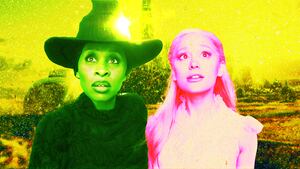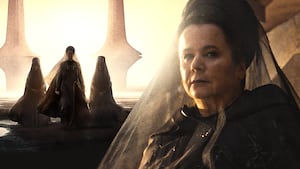An ominous shadow nears the boat. Passengers whisper, “Wow!”
The approaching humpback whale could raise its head and capsize the vessel Netflix rented to show journalists the wonders of the sea. Instead, the behemoth swims beneath and deeper into Monterey Bay.
The underwater world is revealed in Our Oceans, a five-part series premiering on the streamer on Nov. 20.
Each episode focuses on an ocean and the series moves with the current around the world. It begins with the Pacific, and moves to the Indian, Atlantic, Arctic and Southern Oceans. Sure, viewers might think it’s all water, what’s the big difference?
Beautifully shot using cutting-edge technology never before employed at these ocean depths, some marine life behavior is captured for the first time. In Our Oceans, we see so much that is hidden, making the series a rarity in the genre: a nature docuseries that you’ll want to binge like any other Netflix favorite.
If for nothing else, watch just to see Peacock mantis shrimp, a surprisingly gorgeous creature. The series manages to alarm us, as well it should, when we see what’s going on in the Arctic Ocean. Still, there are reassurances throughout, particularly listening to the man who gives us the facts and is having a terrific time doing so.
Former president Barack Obama narrates. Growing up in Hawaii and an advocate for the marine world, his tone often suggests, “Wow!” He’s an executive producer with Michelle Obama and James Honeyborne.

Leaving the boat behind, the humpback joins five others from its pod, each the size of a bus, swimming nearby. The 40-ton whales then position themselves between 10 killer whales and dozens of seals. The wows on the boat turn to gasps.
“I absolutely adore the humpback whales,” Inka Creswell, a marine biologist and assistant producer, says after watching this unfold. “They’re just these beautiful creatures and so empathetic in the way they interact with their calves. And there’s so many complexities to their behavior. I feel like every single time I look at a humpback study, there’s something entirely new, and I’m just fascinated.”
As a scientist, Cresswell is naturally measured; she’s not about to insist these humpbacks are the superheroes of the sea, rushing to protect the seals from the fierce black-and-white orcas. Still, she notes some studies have documented similar behavior, with humpbacks intervening to save seals from becoming meals.
“Why they do that, we don’t quite know,” she says. “It’s either because they have empathy, or it can be because that maternal bond can be so strong, and a lot of them might lose their calves to orcas as well. So, they see something that’s smaller than them, and they instantly kind of take on those maternal instincts.”
The waves are choppy, and for some people onboard, the Dramamine has been flowing. But the filmmakers behind this exquisitely shot series watch this aquatic standoff with smiles. During the five years of making it, 728 crew members on all seven continents and the surrounding five oceans put in over 53,000 hours in the field.
Despite all this experience, those watching humpbacks ward off orcas are just as gobsmacked as the newbies.
The filmmakers’ bona fides are impressive. Our Oceans is from the studio that made Our Planet and from the creators of Blue Planet II. They are proud that this series’ research has sparked some 20 academic papers. Yet they also know that if the films come across as lectures, people will not watch. Our Oceans has a light touch.
Never is that more evident than in the first film, Pacific Ocean. A few guys determined to get the attention of the same female bust out their best moves to a vaguely bossa nova beat. The music is meant to convey the promise of regret in the morning.
She watches them, unimpressed.
Undeterred, they try harder and stage what must be the most fun dance-off ever. Obama provides the play-by-play for the blenny fish mating ritual.
Yes, it’s goofy and one of the many scenes from Our Ocean that could go viral. It’s also utterly charming and does what the series sets out to do: Show us the vast worlds of the oceans and explain why they are crucial to the planet and us.

The intricate dance by 2-inch long fish unfolds on the sandy bottom of Mexico’s Sea of Cortez. We get to see this scene because Cresswell, an assistant producer, spent three weeks working to capture it using a special tripod.
“It hangs the camera just above the sea floor, and that allows us to get that probe lens really close to our marine life and really shoot it at their eye level,” Cresswell explains.
Cresswell had wanted to be a marine biologist since she was a kindergartener in Brighton, England.
“I learned to swim trying to chase a turtle, so I was always going to end up going in that direction, without a doubt,” she says.
This love of water, which covers 71 percent of our planet, is apparent throughout the series as it traverses 75,000 miles. As varied as the waters are, the documentary stresses that, ultimately, it is one ocean as the current moves around the world.
“The global ocean current surges west, carrying warm tropical sea water in what’s typically a 2-year journey from Asia to Africa,” Obama says in Indian Ocean, as an aerial view takes viewers into the 25,000 tropical islands known as the Coral Triangle.
Even in the rich coral reefs, food is scarce, “and every reef resident is on someone else’s menu,” Obama says.
Although most of the oceans are so mysterious, there’s an intimacy to this series borne of the clarity of the underwater photography and the sheer fun of Ho-Ling Tang’s music. Each episode features moments that will make you want to wave your nerd flag high and rush to tell someone about it.
There’s the battle of the two bumpheads, giant fish (160 pounds each, which is a lot of fish) who attack each other in the azure waters of Sipadan Island in Borneo. Their vicious fight, more exciting than the Tyson/Paul fiasco, is based on head-butting. They ram coral reefs with their foreheads and have beaks with teeth that can pulverize pretty much anything.
And, we’ll take true love wherever we can find it, especially among puffins in Atlantic Ocean when a lonely male waits (and waits) for his mate. Seeing survival skills pass among orcas from one generation to the next is heartwarming, though watching them sneak up onto a beach to snack on seals is shocking. In Arctic Ocean, the fastest-changing ocean, climate change is at its most obvious and heartbreaking with the melting ice.
This episode also includes a first captured on film: An octopus as a gunslinger. Those who spend time watching wildlife documentaries have come to appreciate the intelligence and adaptability of octopus. Watching one use a stone as a trajectory to fire through her breathing siphon is wild.
Another impressive first for the series includes the deepest survey ever done beneath the Arctic with cameras taken 3,000 meters, or 9,842 feet, deep.
Filmmakers don’t just lay claim to their firsts without checking with experts.
“We have a really, really close relationship with science and with our series consultant, Professor Steve Simpson from the University of Bristol, and a whole vast array of scientists,” Jonathan Smith, series producer, says. “Also, it’s wonderful quid pro quo because, for us, we get the time that we get to spend in the field observing these animals. It would be remiss if we didn’t share that back to science.”
After decades of working in wildlife filmmaking, Smith says, “With the Netflix platform, we have the ability to reach out to a truly global audience and the opportunity to take the very important message of the oceans–the wonder, the joy, their fragility, the hope they can bring, the hope we can have for them, the difference we can make to them, the difference they can make to us. That really is the foundation of why I put so much into it and why such an incredibly big and dedicated team has given so much, too.
“It never ceased to blow me away with how many incredibly passionate, caring, ocean-loving people there are around the planet,” he continues. “And I really hope that after Our Oceans, there’ll be a whole load more as well.”
Despite the climate crisis, and waters, no matter how remote, polluted with plastic, Smith and executive producer Honeyborne remain optimistic. What gives them hope?
“The ocean’s capacity to heal itself,” Smith says. “If we leave it alone, it will.”
Honeyborne, a dedicated ocean swimmer who spends as much time as possible in the water, explains that the production team weighs potential risks before every shoot.
“If we go there to this base, are the animals here?” he says. “Are they going to be behaving normally? Over the years, there is a sense that there’s more chaos and unpredictability in the system, that nature’s natural cycles are changing.”

That chaos, proven in rampaging wildfires, hurricanes, droughts, and floods, all fosters a sense of urgency. But facts alone so rarely convince people, and so Our Oceans also relies heavily on our feelings by showing animals in situations that we can’t help but relate to. As a polar bear mom searches for food and one of her cubs struggles to keep up, it’s impossible to remain unmoved.
“Across the piece, a very broad range of emotions are being evoked,” Honeyborne says. “I hope by the end of it, you’ll feel rather like you’ve just watched a good movie. It should leave you feeling satisfied, dramatically and story-wise. And I’d go one step further there and say, and I also hope that, because this current journey doesn’t stop, and it kind of throws you into the next hour, that there’s a sense of binge-ability about it, which is unusual for natural history.”
“My deepest hope is simply more people come to love the ocean and its sea creatures,” Honeyborne says. “That’s my biggest because, very simply, as (Jacques) Cousteau observed, we protect what we love, and ultimately, the takeaway in this series is really about ocean health and that while it’s in decline, we have the agency to turn things around.”









